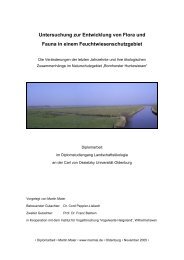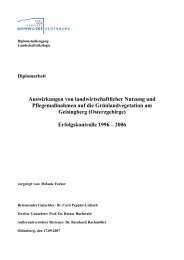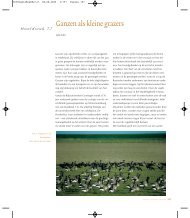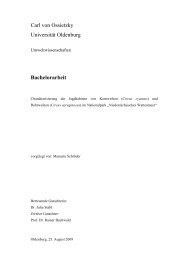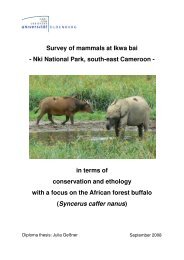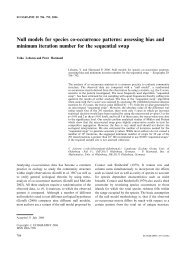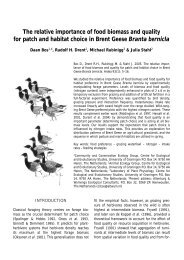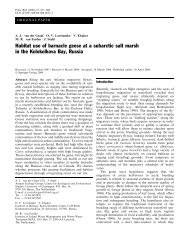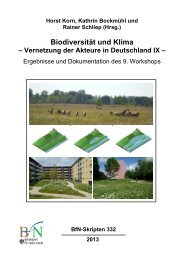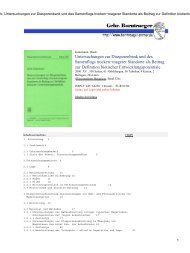The use of habitat models in conservation of rare and endangered ...
The use of habitat models in conservation of rare and endangered ...
The use of habitat models in conservation of rare and endangered ...
Create successful ePaper yourself
Turn your PDF publications into a flip-book with our unique Google optimized e-Paper software.
252<br />
Table 4. Case study 2: Model performance <strong>of</strong> multiple <strong>models</strong>. All performance measures corrected by bootstrapp<strong>in</strong>g. (+^2) <strong>in</strong>dicates that the second order term is <strong>in</strong>cluded to<br />
model an univariate response.<br />
Threshold dependent: P fair<br />
Species pres./abs. Model parameters Threshold<br />
<strong>in</strong>dependent<br />
R 2 N AUC Pfair j Sensitivity Specificity CCR<br />
0.42 0.85 0.21 0.49 0.77 0.81 0.80<br />
Rhopalopyx vitripennis 33/124 Age (+^2) + Moss%(+^2) +<br />
Festuca.rubra/ov<strong>in</strong>a%<br />
0.50 0.90 0.15 0.43 0.75 0.81 0.80<br />
Neophilaenus m<strong>in</strong>or 25/132 50%-height (+^2) + Litter%(+^2) +<br />
Corynephorus.canescens% + BGS75<br />
Neophilaenus m<strong>in</strong>or 25/132 Age (+^2) + BGS75 0.38 0.83 0.13 0.36 0.73 0.78 0.77<br />
Macrosteles quadripunctulatus 58/99 Litter% + pH + BO75 (+^2) 0.41 0.84 0.41 0.52 0.76 0.78 0.77<br />
0.29 0.77 0.17 0.28 0.67 0.72 0.70<br />
Kelisia sabulicola 30/127 Age (+^2) + Veg.dens.0–5 cm (+^2) +<br />
Carex.arenaria%<br />
model for the species (Table 5), with R 2 N at 0.38<br />
<strong>and</strong> AUC at 0.83. Sensitivity <strong>and</strong> specificity were<br />
at 0.76 <strong>and</strong> 0.77, respectively. Out <strong>of</strong> the 28 plots<br />
with<strong>in</strong> the section shown <strong>in</strong> the map (Figure 8), all<br />
n<strong>in</strong>e presences were predicted correctly, six <strong>of</strong> the<br />
19 absences were classified <strong>in</strong>correctly as presences.<br />
Discussion<br />
Case study 1<br />
For V. bensoni, the most important <strong>habitat</strong> factor<br />
was found to be the fertility <strong>of</strong> the grassl<strong>and</strong> sites.<br />
V. bensoni was restricted to low productivity sites.<br />
Consequently, agricultural <strong>in</strong>tensification <strong>and</strong> fertilization<br />
<strong>of</strong> the low productivity <strong>habitat</strong>s would<br />
pose a threat to V. bensoni. Further, the occurrence<br />
<strong>of</strong> V. bensoni would decrease if the tree cover<br />
<strong>of</strong> grassl<strong>and</strong> sites <strong>in</strong>creased, for <strong>in</strong>stance, after<br />
ab<strong>and</strong>onment <strong>of</strong> mow<strong>in</strong>g or graz<strong>in</strong>g. <strong>The</strong>re was no<br />
relationship between the occurrence <strong>of</strong> V. bensoni<br />
<strong>and</strong> the cover <strong>of</strong> s<strong>in</strong>gle grass species. It was known<br />
from literature that V. bensoni lives on grasses <strong>and</strong><br />
it has been argued that V. bensoni may <strong>use</strong> several<br />
grass species as host plants (Biedermann 1998;<br />
Nickel 2003). Our results confirm that V. bensoni<br />
obviously is not a host plant specialist like, for<br />
<strong>in</strong>stance, Neophilaenus m<strong>in</strong>or.<br />
Case study 2<br />
With<strong>in</strong> our dataset, age <strong>of</strong> brownfield sites was the<br />
most driv<strong>in</strong>g factor determ<strong>in</strong><strong>in</strong>g species’ occurrence.<br />
This agrees with the results <strong>of</strong> Small et al.<br />
(2003) for carabid assemblages, who found that<br />
time s<strong>in</strong>ce the last disturbance has a significant<br />
<strong>in</strong>fluence on species’ occurrence. In the study by<br />
Brown et al. (1992), successional age had a strong<br />
effect on leafhopper assemblages. Characteristic<br />
stages <strong>of</strong> brownfield succession strongly depend on<br />
time (Gilbert 1989), but substrate can modify<br />
succession rates considerably (Gilbert 1989; Small<br />
et al. 2003). <strong>The</strong> ma<strong>in</strong> difference between successional<br />
stages lies <strong>in</strong> their vegetation structures<br />
(Hollier et al. 1994). This might be the reason why<br />
<strong>in</strong> two <strong>of</strong> the ‘best’ multivariate <strong>models</strong>, age was<br />
substituted by vegetation parameters. <strong>The</strong>y prob-




